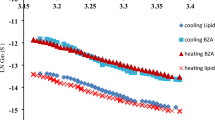Summary
A proteolipidic toxin, prymnesin, when added to the aqueous solutions around thin lipid membranes causes a marked increase in membrane conductance. The toxin-treated membrane is cation-permselective. The extent of cation permselectivity is dependent upon ionic strength of the aqueous solutions in a fashion similar to the dependence of cation permselectivity of a cation exchanger containing about 100mm of fixed negative sites. Dose-response relationship studies reveal a linear relation between log prymnesin concentration and log membrane conductance. The slope of the curve is around 3 if the toxin is applied to one side of the membrane and is around 7 if the toxin is applied to both sides of the membrane. The membrane treated with toxin on one side only is clearly asymmetric in its properties. These characteristics are expressed by an asymmetric current-voltage relationship, and by asymmetric sensitivity of membrane conductance to pH and to salt concentration. The conductance of the toxin-treated membrane is inversely proportional to temperature. It is suggested that aggregates of toxin moieties assemble in the membrane to form negatively charged aqueous pores. There is roughly a good correlation between the increase in membrane conductance and the increase in membrane permeability to urea if both were attributed to the formation of aqueous channels in the membrane.
Similar content being viewed by others
References
Bean, R. C. 1972. Multiple conductance states in single channels of variable resistance lipid bilayer membranes.J. Membrane Biol. 7:15
Cass, A., Finkelstein, A., Krespi, V. 1970. The ion permeability induced in thin lipid membranes by the polyene antibiotic nystatin and amphotericin B.J. Gen. Physiol. 56:100
Dafni, Z., Shilo, M. 1966. The cytotoxic principle of the phytoplagellatePrymnesium parvum.J. Cell Biol. 28:461
Ehrenstein, G., Lecar, H., Nossa, R. 1970. The nature of the negative resistance in bimolecular lipid membrane containing excitability-inducing material.J. Gen. Physiol. 55:119
Finkelstein, A., Cass, A. 1968. Permeability and electrical properties of thin lipid membranes.J. Gen. Physiol. (Suppl.) 52:145s
Goodall, M. C. 1970. Structure effects in the action of antibiotics on the ion permeability of lipid bilayers. III. Gramicidins “A” and “S”, and lipid specificity.Biochim. Biophys. Acta 219:471
Hladky, S. B., Haydon, D. A. 1972. Ion transfer across lipid membranes in presence of gramicidin A. I. Studies of the unit conductance channel.Biochim. Biophys. Acta 271:294
Holz, R., Finkelstein, A. 1970. The water and nonelectrolyte permeability induced in thin lipid membranes by the polyene antibiotics nystatin and amphotericin B.J. Gen. Physiol. 56:125
Lippe, C. 1968. Thiourea and potassium permeability of phospholipid bilayer membranes as affected by enniantin.Nature 218:196
Moran, A., Ilani, A. 1970. Surface tension of an artificial bileaflet membrane in comparison to parent lipid solution-water interfacial tension.Chem. Phys. Lipids 4:169
Moran, A., Ilani, A. 1971. Effect of prymnesium toxin on the electrical conductance of an artificial bileaflet membrane.Israel J. Med. Sci. 7:333
Moran, A., Ilani, A. 1972. Prymnesium toxin and the conductance of bileaflet membranes.Israel J. Med. Sci. 8:574
Mueller, P., Rudin, D. O., Tien, H. T., Wescott, W. C. 1963. Methods for the formation of single bimolecular lipid membranes in aqueous solution.J. Phys. Chem. 67:534
Muller, R. U., Finkelstein, A. 1972. The effect of surface charge on thevoltage-dependent conductance induced in thin lipid membranes by monazomycin.J. Gen. Physiol. 60:285
Shilo, M. 1971. Toxins ofChrysophyceae.In: Microbial Toxins. S. Kadis, A. Ciegler, and S. J. Ajl, editors. p. 67. Academic Press Inc., New York, London
Szabo, G., Eisenman, G., Ciani, S. 1969. The effects of themacrotetralide actin antibiotics on the electrical properties of phospholipid bilayer membranes.J. Membrane Biol. 1:346
Teorell, T. 1953. Transport processes and electrical phenomena in ionic membranes.In: Progress in Biophysics and Biophysical Chemistry. J. A. V. Butler and J. T. Randall, editors. Vol. 3, p. 305. Academic Press Inc., New York
Tien, H. T., Carbone, S., Davidowicz, E. A. 1966. Formation of “black” lipid membranes by oxidation products of cholesterol.Nature 212:718
Tien, H. T., Ting, H. P. 1968. Permeation of water through bilayer lipid membranes.J. Colloid Interface Sci. 27:702
Ulitzur, S., Shilo, M. 1970. Procedure for purification and separation ofPrymnesium parvum toxins.Biochim. Biophys. Acta 201:350
Author information
Authors and Affiliations
Rights and permissions
About this article
Cite this article
Moran, A., Ilani, A. The effect of prymnesin on the electric conductivity of thin lipid membranes. J. Membrain Biol. 16, 237–256 (1974). https://doi.org/10.1007/BF01872417
Received:
Issue Date:
DOI: https://doi.org/10.1007/BF01872417




